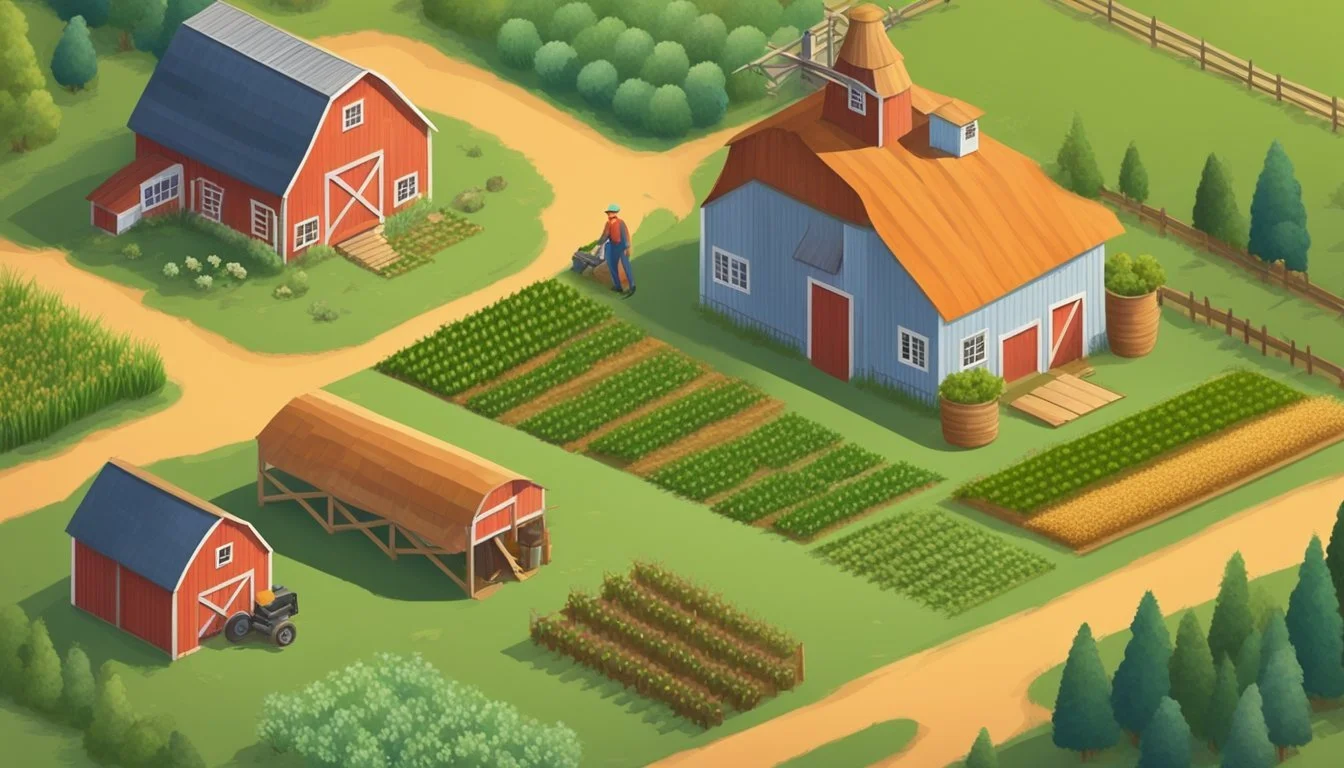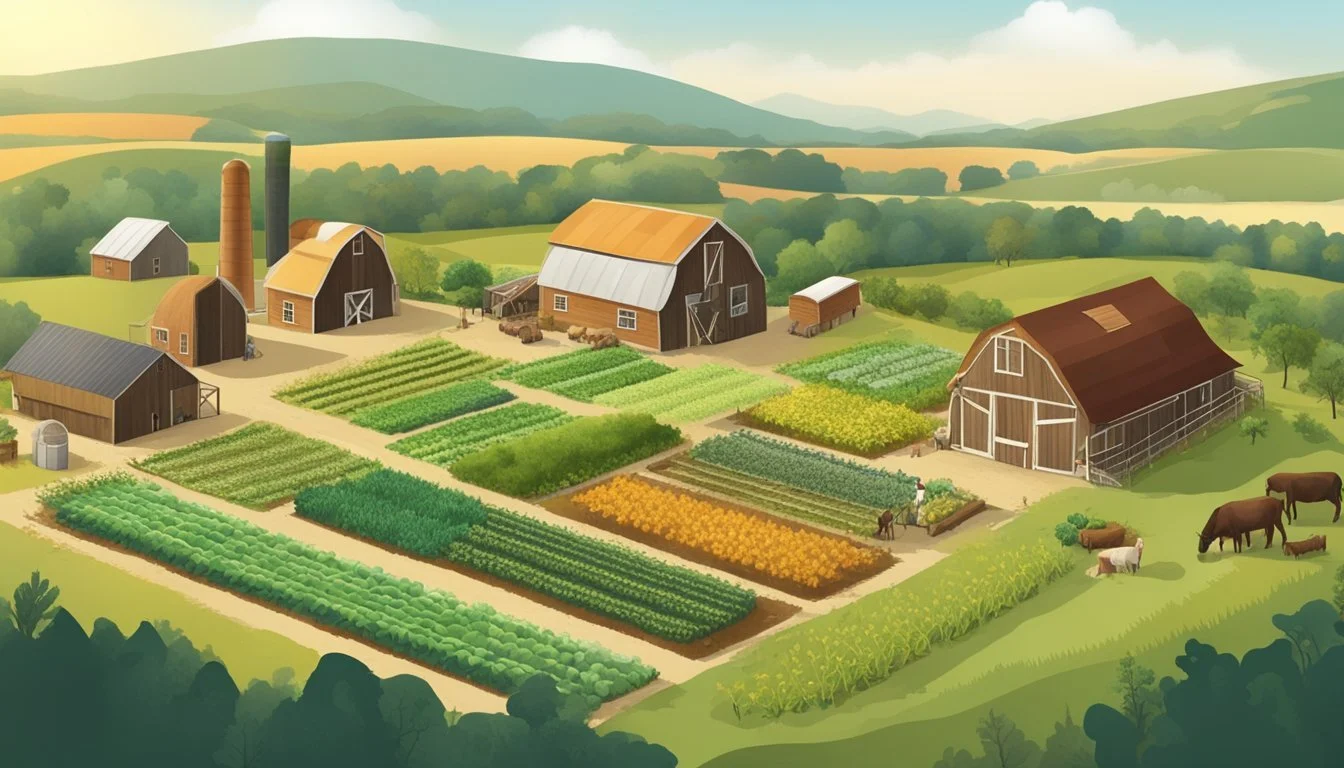The Economics of Small-Scale Homestead Farming
Maximizing Profitability and Sustainability
Small-scale farming plays a critical role in the global economy. Despite its modest size, this sector has a significant impact on food security and sustainability practices. Around the world, small homestead farms are often family-run and contribute to a substantial portion of agricultural production, particularly in developing countries. Economically, these farms not only provide livelihoods for billions but also present a model of agriculture that can balance profitability with ecological stewardship.
The economics of small-scale farming hinge on the principle of maximizing productivity within limited resources. These farms typically operate on smaller plots of land, requiring more innovative and intensive methods of cultivation to yield profitable returns. The agility of small-scale farmers allows them to adapt quickly to market changes and implement sustainable practices, making their approach to agriculture a nexus of economic resilience and environmental care.
Additionally, sustainability is a cornerstone of small-scale farming, with a focus on preserving the long-term fertility of the soil and the surrounding ecosystems. The promotion of local food systems reduces carbon footprints, and sustainable techniques such as organic farming or agroforestry support biodiversity. This model provides a blueprint for a future where agricultural practices are in harmony with the environment, ensuring that productivity does not come at the expense of ecological health.
Historical Context and Present Challenges
The dynamics of small-scale homestead farming stretch across a historical tapestry where persistent economic struggles meet modern environmental challenges. This intricate interplay shapes the livelihoods of smallholder farmers and the quest for food security in developing countries.
Legacy of Smallholder Farms
Smallholder farms have historically been the backbone of the agrarian economy in many developing countries. They hold the critical role of sustaining rural livelihoods and contributing to national food security. Yet, these farmers often face issues of poverty due to limited access to markets, credit, and technological resources. As clarified in scholarly work on the subject, the Homestead Act's ramifications articulated that land granted did not unequivocally lead to economic prosperity for homesteaders.
Economic and Environmental Pressures
Small-scale farms are under increasing economic pressure. They must navigate soil degradation, fluctuating market demands, and infrastructure deficits. Food security remains precarious as these pressures compound the difficulties smallholder farmers confront. Water scarcity is another growing concern, particularly in regions where irrigation is crucial to farming success.
Impact of Climate Change on Agriculture
Climate change is now an undeniable force impacting agriculture on multiple fronts. Increased temperatures, erratic rainfall patterns, and extreme weather events directly threaten the productivity of small-scale farms. These impacts exacerbate existing vulnerabilities and pose risks to the sustainability of smallholder farming systems. The realities of these changes are most acutely felt in developing countries, where the capacities to adapt are often minimal, threatening both current and future food security.
Demographics of Small-Scale Farmers
In examining the demographics of small-scale farmers, it is essential to understand the age and gender dynamics that characterize these populations, alongside the influence of rural-urban migration patterns on agricultural livelihoods.
Age and Gender Dynamics
Small-scale farming often reflects broader age-related trends, with a significant proportion of farmers being advanced in age. The University of California, Santa Cruz presented data indicating that U.S. farmers are aging, with the demographic shifting towards older age brackets. It's a pivotal aspect of agricultural demographics requiring attention to ensure that skills and knowledge are passed down to younger generations.
Gender plays a critical role in small-scale farming, with disparities in access to resources and decision-making power. Data shows variability in gender participation rates among small-scale farmers across different regions, with both men and women making significant contributions to food production and farm management.
Rural Population and Migration Patterns
Rural areas are the predominant location for small-scale farms, which serve as the backbone of local food systems and economies. These farms provide livelihoods for a substantial part of the population in rural communities. However, many regions experience rural-urban migration, which can lead to a decrease in the rural labor force and affect farming practices and sustainability.
This migration is often driven by the search for better education, employment, and social services in urban areas. The implications of this trend for small-scale farming include potential labor shortages and an increase in the average age of the rural population, thereby impacting the demographics and economic resilience of rural communities. The population increase in urban centers further underscores the crucial role of small-scale farmers in meeting the food demands of a growing population.
Land and Resource Management
Effective land and resource management is crucial for small-scale homestead farming, focusing on soil conservation, water management, and biodiversity. These practices are designed to enhance sustainability, maximize the use of arable land, and improve overall crop production.
Soil Conservation and Crop Rotation
Soil conservation is a key aspect of sustainable farming. By implementing crop rotation, farmers can prevent soil degradation and maintain nutrient-rich, fertile land. The rotation of diverse crops reduces the risk of pest infestations and disease, minimizes the dependence on chemical fertilizers, and can increase soil organic matter. For example, a four-year rotation might involve planting nitrogen-fixing legumes followed by grains and then root vegetables.
Year 1: Legumes (e.g., beans, peas) Year 2: Grains (e.g., wheat, oats) Year 3: Root vegetables (e.g., potatoes, carrots) Year 4: Restorative crops (e.g., clover, green manure)
Water Management Practices
Efficient water management practices are vital, especially in regions with limited water resources. Techniques such as drip irrigation conserve water by directing it precisely where it's needed. The use of mulches can reduce evaporation from the soil surface, conserving water and simultaneously controlling weed growth. Water harvesting, the collection, and storage of rainwater for agricultural use, can provide an essential buffer against the variability of rainfall.
Drip Irrigation: Accurate water delivery, reduced wastage
Mulching: Water retention, weed management, soil temperature moderation
Water Harvesting: Sustainable water supplementation, drought mitigation
Ecosystem and Biodiversity Stewardship
Homestead farms play a crucial role in promoting biodiversity and maintaining healthy ecosystems. By preserving a range of plant and animal species, these farms can foster natural pest control and pollination services, which are essential for robust crop production. The creation of habitat zones, such as hedgerows or wildflower meadows, attracts beneficial insects and wildlife, and the avoidance of monocultures helps to maintain an ecological balance.
Biodiversity Approaches:
Create biodiversity hotspots (e.g., wildflower meadows)
Integrate agroforestry practices
Maintain habitat diversity within the farm landscape
Scale of Operation and Productivity
The relationship between the scale of operations in small-scale homestead farming and productivity is complex. Factors such as farm size variance, use of fertilizers and pesticides, and the extent of crop diversification all play significant roles in influencing outputs.
Farm Size Variance and Output
Small-scale homestead farms exhibit a wide variety in farm size, with each making strategic choices based on the land available and the farmer's objectives. Research indicates that smallholder farmers may achieve high levels of productivity per unit of land, despite the constraints of smaller farm sizes. However, as farm size increases, the potential for mechanization and improved efficiency can lead to greater overall yields.
Key Considerations:
Small farm size can limit the adoption of advanced technologies that require scale.
There is often an inverse relationship between farm size and output per hectare: smaller farms tend to use land more intensively.
Fertilizers, Pesticides, and Crop Diversification
The strategic use of fertilizers and pesticides forms a critical part of the productivity equation for homestead farming. Small farms often rely on these inputs to boost yields but must balance this against the costs and potential environmental impacts.
Crop diversification is another tactic employed by small-scale farmers to improve resilience and productivity. It can reduce the risk of total crop failure, promote soil health, and meet various market demands. Diversified farms may also better support ecological services, like pollination and pest control, which in turn can reduce reliance on chemical inputs.
Crop Diversification Benefits:
Enhances food security by providing a variety of crops.
May improve nutritional outcomes for the household and local community.
Serves as a risk management strategy against climate variability.
Implementing crop diversification, alongside judicious use of fertilizers and pesticides, is essential for maintaining soil fertility and achieving sustainable productivity on small-scale farms.
Technological Innovations in Small-Scale Farming
Technological innovations have drastically transformed small-scale farming, improving efficiencies and outcomes. These advancements have led to the adoption of precision agriculture tools, sustainable practices, and data-driven solutions, significantly influencing the productivity and profitability of small farms.
Adoption of Agriculture Technology
Farmers are increasingly integrating agriculture technology to enhance decision-making and operational effectiveness. The implementation of Internet of Things (IoT) devices allows for real-time monitoring and control of farm conditions, leading to better resource management. For instance, irrigation automation systems can be used to provide plants with the precise amount of water needed at the right times, conserving a significant amount of water and energy. Similarly, access to smartphones has empowered farmers to receive and act on agricultural information promptly, improving both their yields and livelihoods. The Small-Scale Farming Review details these trends and suggests further expansion in the coming years.
Precision Agriculture and Sustainable Practices
Precision agriculture technologies, such as GNSS and auto-steering, enable small-scale farmers to optimize field-level management with a high degree of accuracy. With these tools, they can reduce wastage and minimize their environmental footprint. Through the use of crop and soil sensors, farmers can obtain detailed insights into soil health and crop needs, thus applying fertilizers and pesticides in a more targeted and eco-friendly manner. Implications of these precision tools on sustainability are discussed in this Digital Agriculture Article.
Data-Driven Farming Solutions
The backbone of modern small-scale farming lies in its ability to harness data. Yield monitoring systems collect harvest information that, when paired with yield mapping technology, provides invaluable insights into crop performance. This amalgamation of data facilitates informed decision-making that can lead to improved crop yields and quality. Furthermore, artificial intelligence (AI) and robotics are being employed to analyze this data, leading to predictive behaviors and fine-tuned farming operations. Research on the economic factors affecting technology adoption by small-scale farmers is found in a comprehensive study by Taylor & Francis Online.
Access to Markets and Economic Viability
Access to markets significantly influences the economic viability of small-scale homestead farming. Effective marketing strategies, efficient infrastructure, and meeting consumer demands for food traceability contribute to the sustainability and growth of smallholder farms.
Marketing Strategies for Smallholders
Market Orientation: Smallholder farmers benefit from aligning their production with market demands. This is achieved by understanding consumer preferences and adjusting crop selection accordingly. In Nigeria, for instance, market orientation for organic farming enables small producers to achieve better prices and improves the quality of their goods.
Diversification: A diversified approach mitigates risks and creates multiple revenue streams. Engaging in a mix of crops and livestock can lead to a more stable income, as the variety caters to different market periods and consumer needs.
Infrastructure and Supply Chain Efficiency
Transportation Networks: Efficient transportation and logistics infrastructure are crucial for smallholders to access both input and output markets. These improve the timeliness of deliveries, reducing post-harvest losses and enhancing product freshness upon reaching consumers.
Supply Chain Partnerships: Collaboration with local businesses, such as distributors or processors, can streamline the supply chain. Such partnerships ensure smooth operations and potentially provide small-scale farmers with leverage in negotiations.
Food Traceability and Consumer Demand
Traceability Systems: With an increasing consumer demand for knowledge about food origins, small-scale farmers who invest in traceability can gain a competitive advantage. Traceability systems help in certifying the authenticity of farm produce and can cater to niche markets seeking organic or local products.
Consumer Preferences: Understanding and responding to consumer preferences can enhance market access for smallholder farmers. By demonstrating how their farming practices meet health, safety, and ethical standards, farmers can capture more value and build brand loyalty.
By addressing these three key areas — marketing strategies, infrastructure, and consumer preferences linked to food traceability — small-scale homestead farming can navigate the complex market dynamics to ensure economic growth and sustainability.
Social and Economic Impact
The economics of small-scale homestead farming hold a substantial influence on local and broader economies. This section investigates their role in bolstering community employment and incomes, enhancing food production, securing nutrition, and fostering self-sufficiency.
Contributions to Local Economies
Small-scale homestead farming significantly boosts local economies. These farms create employment opportunities, often being a primary source of jobs in rural areas. Their operations tend to require a varied set of skills and labor, from field work to market sales, igniting a chain of economic activities. Farmers often spend their incomes locally, stimulating the growth of community businesses and services. Furthermore, the agro-processing sector is a major beneficiary of small farms, which provide raw materials, thus enhancing the community's economic landscape.
Promotion of Food and Nutrition Security
By prioritizing crop diversification, small-scale farmers have a hand in food and nutrition security. The variety of crops not only offers nutritional benefits but also decreases the risk of total loss due to disease or pests. A homestead's food production directly contributes to the nutritional needs of local communities and has the potential to impact wider regions. Introducing robust and nutrient-rich food options, farmed locally, these homesteads help to combat malnutrition and ensure a stable food supply — foundational in crises or when facing market fluctuations.
Empowerment through Self-Sufficiency
Reaching a level of self-sufficiency is often a hallmark of success for small-scale homesteads. Farmers gain independence in food production, which in turn can lead to improvements in household income and stability. They are less reliant on external food sources and can weather economic challenges with more resilience. As highlighted by a Harvard University study, the capacity for farmers to own and cultivate their land was fundamental to their economic development strategy, marking a shift toward greater autonomy and economic empowerment.
Policy and Institutional Support
The sustainability and profitability of small-scale homestead farming is often contingent upon the effectiveness of policy and institutional support. Specific measures from governmental and non-governmental entities, as well as financial services, are essential for empowering these agricultural endeavors.
Role of Governments and Policymakers
Governments and policymakers play a pivotal role in developing and implementing policies that can bolster the agricultural sector. By establishing land transfer service centers, they facilitate easier access to land rental markets and decrease transaction costs which are crucial for small-scale farmers. Furthermore, policymakers can aid in fostering farm operations advancements within China through institutional innovation. Equally important are the policies that accelerate land consolidation and provide farm mechanization services, driving forces in the recent evolution of farm operations.
Non-Governmental Organizations and Advocacy
Non-Governmental Organizations (NGOs) are key in supporting small-scale homestead farming through advocacy and programs aimed at security and sustainability. NGOs can disseminate innovations in smallholder agriculture, playing a vital role in achieving large-scale impact in impoverished farming regions. They often partner with local communities to advocate for policies that are favorable to small-scale farmers and provide essential training and resources.
Access to Credit and Financial Services
Access to credit is paramount for the growth and efficiency of small-scale farms. Credit availability allows farmers to invest in necessary resources, thus enhancing their productivity and financial security. Financial institutions have recognized this need and are increasingly facilitating credit, special loans, and other financial services aimed specifically at the agriculture sector. This support is crucial for smallholder farmers in overcoming fiscal barriers and capitalizing on technological advancements to improve their operations and output.
Challenges and Opportunities Ahead
Small-scale homestead farming faces a nuanced landscape of hurdles and prospects. Climate volatility and rapid market changes present challenges, while technological innovations and education offer pathways for growth and resilience.
Adapting to Future Demands and Climate Uncertainty
The unpredictability of climate change looms large over small-scale farmers. They are tasked with the challenge of maintaining crop yields despite erratic weather patterns and shifting temperatures. These farmers must stay abreast of climatic fluctuations to plan their sowing and harvesting cycles effectively. Adapting to the future will also entail shifting to drought-resistant crops and practicing water conservation to safeguard against the risk of agricultural losses.
Innovations in Farming for Economic Development
Technological advancements have the potential to transform small-scale agriculture by boosting efficiency and increasing yields. The introduction of precision agriculture tools, like soil sensors and drones, can foster significant economic growth. Smart farming technologies enable small-farm owners to make informed decisions that optimize resources and enhance productivity.
Educational Resources and Knowledge Sharing
The gap in educational resources and lack of awareness is a significant barrier. Improvement in this area can lead to better farm management and informed decision-making. Initiatives that focus on skills training and the dissemination of agricultural knowledge, such as extension services and online information platforms, can empower farmers. Community-led knowledge sharing can play a critical role in spreading innovative techniques and organic farming practices that may lead to sustainable development.








